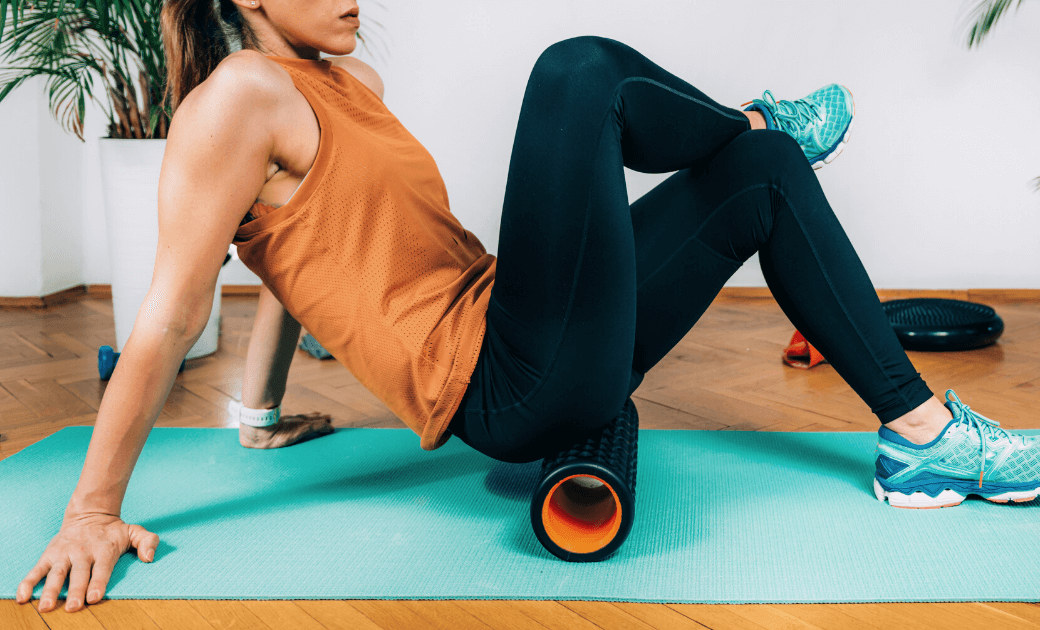Flexibility Training for Performance and Recovery

For most of us, the primary focus in our training routines is on progressing toward the big goal itself: Running faster, lifting more weight, getting in top shape for competition, and more. However, many athletes tend to fall short in the area of flexibility work, which is an essential component of performance, recovery, and injury prevention.
A tight, inflexible body will contribute to muscle imbalance and lower quality of movement, not to mention increasing the likelihood of getting hurt. It’s extremely important to take time before and after training, as well as during your down time, to focus on stretching and flexibility.
Foam rolling and stretching as part of your training session, as well as adequate warmup and cooldown periods, can help you improve your flexibility and mobility. In addition, consider incorporating flexibility-oriented exercise, like yoga, into your recovery time.
Self-Myofascial Release (SMR)
Self-myofascial release refers to a variety of techniques that you can use to increase flexibility, reduce muscle tension, and address movement imbalances by massaging muscle and connective tissue (myofascia). Foam rollers are one of the most common SMR tools, and they come in a variety of textures, sizes, shapes, and degrees of firmness. Other SMR tools include deep tissue therapy guns, massage hooks, TENS units, massage balls, foot rollers, and even standard lacrosse balls.
Use your SMR tool of choice to target knots in individual muscles and tight spots in muscle groups. Apply gentle but firm pressure to the area for at least 30 seconds or until you feel a release. Note: Effective SMR takes practice and can be uncomfortable at first – stick with it, and your efforts will pay off!
Dynamic Movement
Every training session should include a proper warmup. To make sure your body is prepared to perform the movements in your workout, incorporate dynamic range-of-motion movement into your warmup interval. This is a form of active stretching that helps develop greater mobility and control through your entire range of motion, and promotes better flexibility in the joints and muscle tissues.
Some examples of dynamic movement include arm circles, walking lunges, bodyweight squats, marching toe touches, and side shuffles. For greatest benefit, the dynamic movements incorporated into your warmup should somewhat mirror the movements in your training session. For example, a boxer could incorporate twisting motions and shoulder mobility exercises into their warmup, while a powerlifter might focus on squatting and hinging motions to support heavy squat and deadlift exercises.
Static Stretching
This “traditional” style of stretching primarily involves moving the body into a stretched position and holding that pose for an extended period of time to lengthen a muscle or group of muscles. Seated toe touches, quad pulls, and standing calf stretches are common static stretches.
Static stretching is most effective when performed while your muscles are already warm, such as following a warmup period or during a cooldown, after the training session is completed. This type of stretching helps promote healthy circulation, improves muscle flexibility, reduces tightness and soreness following the workout, and is extremely beneficial to recovery time and quality.
Flexibility Exercise
Finally, consider incorporating some flexibility-focused exercise into your rest day or recovery time! Exercise types such as yoga, Pilates, tai chi, or specialized mobility programs can help you develop balance, flexibility, and motor control. In addition, these styles of movement also increase blood flow to recovering areas of the body, help regulate hormonal balance, reduce physical and mental stress levels, and can leave you feeling replenished for the next hard training session.
Most of us could seriously benefit from including more recovery exercise into our schedules. Fortunately, you don’t need to go to a studio or fancy boutique gym to do this kind of exercise – all you need is a little floor space, a mat, and a video to follow along with (you can find endless options online). So settle in, loosen up, and start enjoying the benefits of flexibility in your routine!
This article is part of our April blog series on athletic performance and recovery. Follow along with us as we explore how Nutrition, Hydration, Stretching, and Rest all contribute to improved recovery for athletes!
Leave a Comment